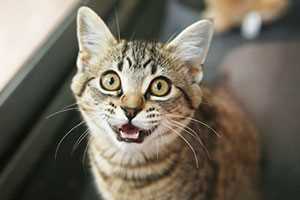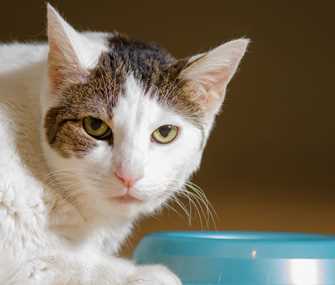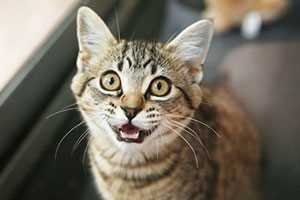

After finishing my meal, I often express my feelings through a series of vocalizations. This behavior can stem from a variety of reasons, and it’s important to pay attention to the context. For instance, if I sound particularly chatty, it might indicate that I’m excited or content with my feast.
Another reason for my vocal antics could be a way of seeking attention. After a satisfying meal, I might want to engage with my human, signaling that I’m ready for some playtime or cuddles. Observing my tone and volume can provide clues about what I’m trying to communicate.
Additionally, sometimes I may feel a bit uneasy after eating, especially if my meal was larger than usual or if it didn’t sit well with me. In such cases, my sounds could be a way of expressing discomfort or seeking reassurance from my guardian. Keeping an eye on my eating habits and behaviors can help in understanding my needs better.
Understanding My Vocalizations Post-Meal

Right after I finish my bowl, I often express myself vocally. This behavior stems from various factors, each revealing something about my personality and needs.
Communication of Contentment
One reason for my chatter is sheer happiness. A full belly makes me feel satisfied, and I like to share that joy. It’s my way of saying, “That was delicious!” to my human. This playful banter can also strengthen our bond.
Seeking Attention

Sometimes, I’m simply looking for some extra love. After a meal, I might want to engage, whether it’s for a cuddle or some playtime. My sounds can be an invitation to my human, asking for companionship and interaction.
Overall, these vocalizations reflect my emotions and desires. Each sound carries a message, and I enjoy communicating with my human in my own unique way.
Understanding Communication Styles
It’s vital to recognize that we express ourselves in various ways. Each sound or action carries meaning. For instance, some vocalizations signal excitement or contentment, while others may indicate discomfort or a need for attention. Observing body language alongside vocalizations enhances understanding.
Vocal Patterns and Their Meanings
Soft purring usually means happiness or relaxation, often felt during moments of affection. On the other hand, higher-pitched sounds can signal distress or a call for help. Pay attention to the tone and frequency to grasp the underlying message.
Body Language Insights
Not only sounds convey thoughts. Tail position, ear orientation, and eye contact provide additional context. A raised tail often signifies confidence and friendliness, while flattened ears may indicate fear or aggression. Combining these visual cues with vocalizations creates a clearer picture of what I’m trying to communicate.
Spending time observing these interactions fosters a deeper connection. Understanding these nuances helps in responding appropriately, ensuring a harmonious relationship.
Common Reasons for Post-Meal Meowing
Feeling satisfied yet still expressing myself is quite normal. Many of us vocalize our thoughts after a meal, and here are some common reasons why that happens.
Attention Seeking
Sometimes, I just want to grab the attention of my human. A little vocalization can signal that I crave some affection or interaction right after enjoying a tasty meal.
Hunger Signals
Even if my bowl is empty, I might meow to remind my human that it’s time for another serving. This behavior often stems from a strong instinct to ensure food availability.
| Reason | Description |
|---|---|
| Attention Seeking | Wanting to engage with my human after eating. |
| Hunger Signals | Indicating the need for more food even after finishing a meal. |
| Discomfort | Expressing feelings of unease or digestive issues post-meal. |
Occasionally, I might feel discomfort due to digestion or an upset stomach. If it happens often, a visit to the vet might be necessary to ensure everything is alright.
Lastly, maintaining a proper grooming routine is important. A good brush for maine coon cats can help with that, keeping my fur neat and tidy, which might also reduce some post-meal fussiness.
In addition, if my human has a pressure washer, using the best polyurethane pressure washer hose can help keep our environment clean, which is equally essential for a comfortable living space.
How to Differentiate Between Hunger and Other Needs
Pay attention to my body language. If I’m pacing or staring at my food bowl, it’s likely I’m still feeling hungry. On the other paw, if I’m relaxed and lounging, my vocalizations may indicate something else entirely.
Vocalization Patterns
Not all sounds mean the same thing. A soft, chirpy noise often signals that I’m seeking attention or playtime, whereas a more intense and persistent sound can indicate an unmet need. It’s important to distinguish these tones to understand what I truly want.
Context Matters
Consider the situation. If I’ve just polished off my meal but still approach you with a few soft calls, I might be in the mood for some affection or a cuddle. If I’m lingering near the food bowl, it’s a clear sign I’m looking for another serving. Observing my habits and routines will help you interpret my needs more accurately.
Health Issues That May Cause Excessive Vocalization
Frequent vocalizations can indicate underlying health concerns. If you notice unusual sounds, consider scheduling a vet visit. Conditions like hyperthyroidism, diabetes, or dental issues often lead to increased vocal activity. These ailments can cause discomfort or distress, prompting meows as a form of communication.
Common Health Problems
Hyperthyroidism is prevalent in older companions. Symptoms include increased appetite but weight loss. Regular check-ups can help detect this early. Diabetes may also result in excessive thirst and hunger, contributing to vocal requests for more food. Dental pain can cause discomfort, leading to noise-making as a response to pain during or after meals.
Behavioral Considerations
Sometimes, behavioral factors intertwine with health issues. Stress or anxiety can manifest through frequent vocal expressions. Changes in environment, such as moving or new pets, might trigger this response. Identifying the root cause and addressing it can significantly reduce such behaviors. Always consult with a veterinarian to rule out medical conditions before assuming it’s a behavioral issue.
Tips to Manage Your Feline’s Post-Meal Behavior
Creating a calm environment is essential. Consider limiting noise and distractions during meal times. Soft music or white noise can help soothe anxious spirits.
Establish a Routine

Consistency is key. Feed at the same times each day to help regulate behavior. This can reduce anxiety and expectations that lead to vocalizations.
Interactive Feeding Solutions
- Use puzzle feeders to engage the mind. It slows down eating and can reduce post-meal chatter.
- Try timed feeders to create anticipation without immediate vocal demands.
Monitor hydration levels. Ensure fresh water is always available. Sometimes, sounds arise from thirst rather than hunger.
Observe body language closely. Recognizing signs of discomfort or distress can help address underlying issues before they escalate.
Reward Calm Behavior
- Use treats or affection when silence follows a meal. Positive reinforcement can encourage more peaceful post-meal moments.
- Avoid responding to vocalizations with attention; this can inadvertently reinforce the behavior.
Regular veterinary check-ups are crucial. Health concerns may contribute to excessive vocalizations, so maintaining an open line of communication with your vet is advisable.
FAQ:
Why does my cat meow after eating?
Cats may meow after eating for several reasons. One common reason is to communicate their satisfaction or to request attention from their owner. They might have enjoyed their meal and want to share that feeling with you. Additionally, some cats may meow if they are still a bit hungry or if they are looking for treats or more food. It’s also possible that they are expressing discomfort or a need for playtime. Observing their body language and behavior can provide clues about the specific reason for their vocalization.
Is it normal for my cat to meow loudly after meals?
Loud meowing after meals can be normal, but it can also indicate different things depending on the cat’s personality and health. Some cats are naturally more vocal than others, and they might meow loudly simply to express their excitement or to get your attention. However, if the loud meowing is accompanied by signs of distress, such as pacing or looking uncomfortable, it might be a sign of digestive issues or other health concerns. It’s important to monitor their behavior and, if you’re concerned, consult with a veterinarian for advice.
What should I do if my cat keeps meowing after eating?
If your cat continues to meow after eating, first assess their behavior. Are they seeking attention, or do they seem anxious? If they look happy and playful, they might just want to engage with you. However, if their meowing seems excessive or is accompanied by other unusual behaviors, it’s a good idea to check if they are experiencing any discomfort. Ensure they are not hungry again or have access to fresh water. If the behavior persists and causes you concern, consulting with a vet can help rule out any underlying health issues.
Can my cat’s meowing after eating indicate a health problem?
Yes, if your cat’s meowing after eating is unusual or excessive, it could indicate a health issue. Conditions such as gastrointestinal distress, dental problems, or even anxiety can lead to increased vocalization. Cats may express discomfort or pain through meowing, so it’s important to pay attention to any other signs such as vomiting, lethargy, or changes in appetite. If you notice these symptoms along with the meowing, it’s advisable to seek veterinary care to ensure your cat’s health is not at risk.









